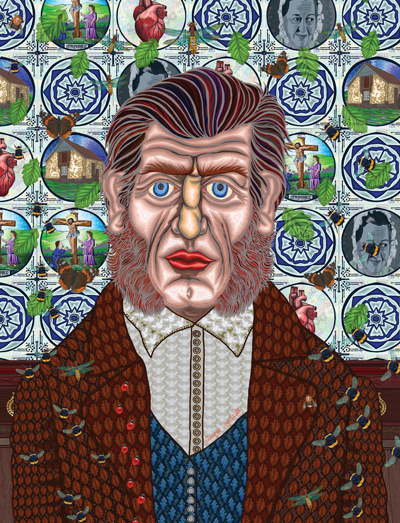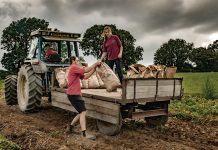
Artist Jason Wilsher-Mills talks to Fergus Byrne about his upcoming exhibition in Dorchester
As a youngster, Jason Wilsher-Mills was a keen rugby league player. So keen, and also so talented, that he had scouts from some of the big league clubs taking an interest in his future. Little did any of them imagine that that future would go in a completely different direction. Captain of his team, already over five foot tall and broad-shouldered, Jason contracted chicken pox at 11 years of age. It developed into chronic Polyneuropathy and left him paralysed from the neck down. ‘I didn’t grow much after that’ quips Jason, ‘but I would probably have been well over six foot.’
He was in hospital for over a year, and while doctors came and went, suggesting polio and various other possible diagnoses for his condition, there was never a definitive conclusion. ‘Even the Polyneuropathy is like the nearest thing they could get to’ he explains. From 11 to 16 he was in full-time care, reliant on his parents for everything. The rest of his life was a slow battle to recover what movement he could and claw back as much use of his limbs as possible. ‘But I recovered’ he says. ‘I say “recovered” in inverted commas because I never really recovered. The fact that I’m using a wheelchair now tells its own story really.’
The process took him on a career path he hadn’t imagined initially. In March he will be unveiling an exhibition of his new augmented reality artwork, bringing the story of the Tolpuddle Martyrs to life like never before. The exhibition is the next step in a career as an artist that has seen him exhibit with Grayson Perry at the V&A; show art in the Tate Modern; create a banner for display in the Houses of Parliament and have work commissioned to exhibit at the Museum of Islamic Art in Qatar. Something he described as ‘like being asked to play for England!’
This year he has also been shortlisted for Unlimited Art Funding; an initiative that supports disabled artists who are in mid-career, to help them get to the next level. ‘Fingers crossed I might be creating permanent art for Finsbury Park, the National Children’s Museum and many other places that will all connect using technology. I’m also doing work commissioned for the International Freedom Festival,’ says Jason.
The Shire Hall exhibition came about because of a chance meeting with members of the Shire Hall project at the unveiling of his banner created for the Disability Discrimination Act at the Houses of Parliament. He will be using augmented reality technology to superimpose computer-generated films, images and interactive components on what someone is seeing in the real world. This could be by using a tablet or mobile phone to view the original artwork and then ‘seeing’ the augmented part as 3D on the screen. The exhibition, called Tolpuddle Martyrs Remixed: Six Dorset men who changed the world, is something that Jason is very excited about. It is the initial step in an augmented reality project that he plans to develop further in the coming years. ‘It’s absolute cutting-edge technology’, says Jason. ‘There’s no other museum that’s using that technology.’
The technological advance is a long way from his initial sketches while recovering from his illness. One of eight children, Jason came from a very working-class background, but he was encouraged by his parents to draw. When he became disabled, the doctors suggested he probably wouldn’t live beyond seventeen. ‘I’m fifty next week!’ he laughs. But his parents were very supportive of his doing what he wanted to do. ‘I went on to University and was really quite passionate about art.’ After graduating, he took up teaching, unsure about whether he should paint. He explained: ‘I definitely wasn’t ready to do what I do now when I was in my twenties. I felt I had to do other things like teaching. I taught art in a prison for many years. Art has always been there, but it’s having the courage to make the step.’
About ten years ago he was in a slump, feeling he couldn’t achieve anything when one of his friends told him he should paint his way out of it and suggested using an iPad. This was something Jason had never heard of. ‘And literally within three months of getting one, I had work on show in San Francisco. That quick it was bonkers.’ He explained that he felt he had to mature a bit before taking the step to being a professional artist. ‘But I worked really hard, and I’m really ambitious in what I do, and it’s sort of paid off.’
He sees a strong relationship between his work on the Tolpuddle Martyrs and his background. ‘I’m a northerner from Wakefield in Yorkshire’ he says. ‘My Dad was a coal miner, and I have really vivid memories of the miner’s strike. I grew up seeing lots of trade union banners. We were brought up going to coal miner’s galas. It was a really important part of our lives, but we didn’t know that it was to do with being socialist or left wing. It was just part of our lives.’
He can remember arguing with his Dad about the miner’s strike. ‘Like all teenager’s I thought I knew better’ he says. He saw ‘highly edited’ pictures on television of violent protest and asked his Dad why they were fighting. “Well, they’re fighting for their jobs lad”, replied his father. Later in life, he did work for the coal miner’s industry and remembers meeting people that had been on the front lines of the miner’s strike. He met people who recalled being bundled into the back of a police van only to find that underneath the police uniform many of them had army uniforms on. ‘One guy recognised his own Sergeant from when he’d been in the army.’ The sergeant warned the man that as he had signed the Official Secrets Act, he mustn’t tell anyone.
Jason points out that his upbringing, surrounded by the area and people where the trade union movement started, informed his own political beliefs. Although he understands that the men that went on to become known as the Tolpuddle Martyrs had their own brotherhood based on their religious beliefs, he could see the injustice of them being punished for considering forming a trade union. ‘With my own political beliefs and being a disabled artist in contemporary times, I use my voice to campaign and describe and deal with what it is to be a disabled person. I kind of felt there was an affinity there.’
He came to Dorset last year to spend a few weeks doing workshops in schools and talking about the Tolpuddle Martyrs. ‘It was amazing how many kids had family members that were connected in some way to the story.’ He carried on gathering information and putting together ideas for the commission, which required an individual piece about each martyr, or “Dorsetshire labourer” as they are called. ‘Which is quite an important definition’ he explains, ‘because, at the end of the day, they were just ordinary men who were caught up in an extraordinary story. First and foremost they were passionate about their beliefs. They actually built the chapel in Tolpuddle, and they were committed Methodists. The work I wanted to do was about that and returning them to the land and showing how important the church and Dorset was to them. It was also about how important they were as individuals. Because it’s almost as if the Tolpuddle Martyrs have become a mythology, so the work is trying to get back to the real men and the families. They were all passionate about their families, and that’s what kept them going.’
His plans for the future include taking the idea of people like the martyrs and bringing it into the discussion about disability. ‘In terms of disability we’re not that different to those guys meeting round the tree’ he says. ‘It’s an understanding that it’s a real fight. I think George Loveless—one of the martyrs—he was an ordinary guy, he was a passionate speaker and was very charismatic. I’ve tried to make him look like an old-time prophet from the Old Testament. Almost like Charlton Heston with the crazy hair, coming down from the mountain, inspiring these men to do something that would transform their lives. They were ordinary guys that had to do something because they were left with no choice. I can recognise that in my own situation.’
There is a strong thread running through the work that Jason Wilsher-Mills pursues. He takes the battle forward for those with any kind of disability and shows a vital awareness of injustice, especially for those that have to rely on the state to help them survive. ‘I have a friend who is an ex-Paralympian’ he says. ‘She’s never walked. She never will walk. She’s been in a wheelchair all her life but had her disability benefits taken away because the doctor didn’t give a detailed enough explanation of her condition.’
He points out that it’s hard enough for people with autistic disorders, mental health issues or ‘invisible illnesses’ to get help. ‘Although you’d think that if you had a leg missing or were using a wheelchair, they’d figure out there was a problem.’
He also works with adults with learning disabilities. ‘It’s about telling their stories and using the tools that I have to do that.’ One of his current projects is producing a sculpture at the University of Hull which is all about the disabled people in Hull, ‘the communities, the hidden stories and quiet voices—and giving them a platform to express themselves—it needs doing as well.’
Jason Wilsher-Mills’ exhibition Tolpuddle Martyrs Remixed: Six Dorset men who changed the world will be open to the public at the Shire Hall Historic Courthouse Museum in Dorchester from March 19th to June 14th.
For more information visit shirehalldorset.org.









